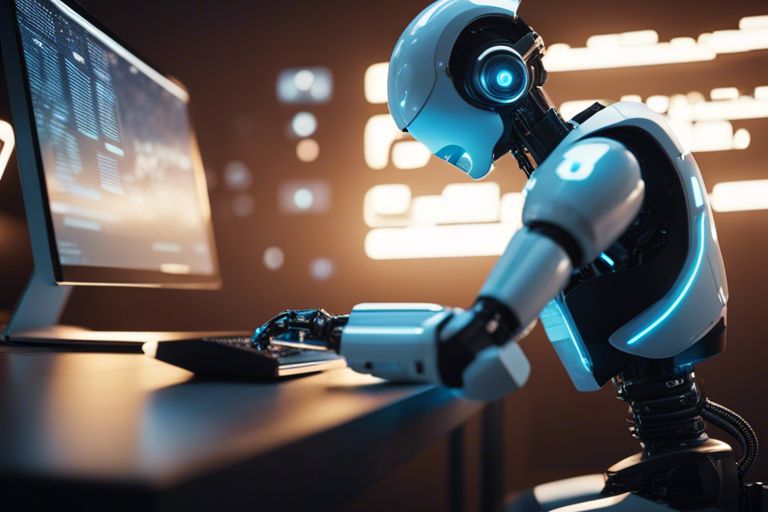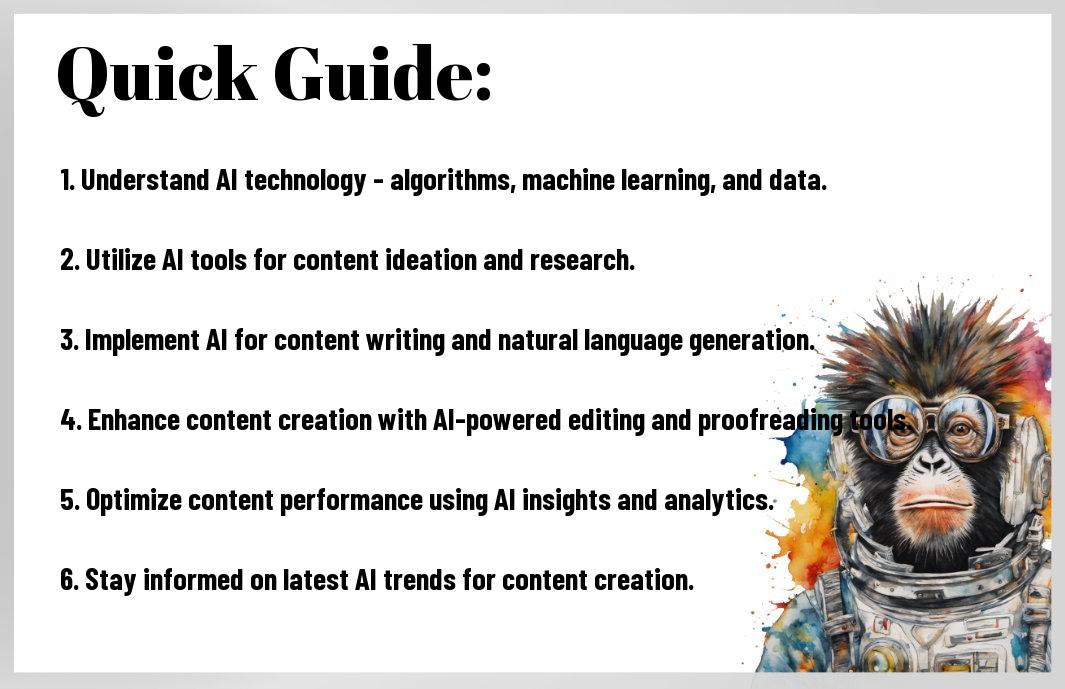This ultimate guide will research into the fascinating world of artificial intelligence and its profound impact on content creation. From writing to design, AI technology is revolutionizing the way we produce and consume content, opening up endless possibilities for innovative and engaging creations. Join us as we explore the various ways AI is transforming the content creation landscape and discover how you can leverage this powerful tool to enhance your own creations. Whether you’re a seasoned content creator or just getting started, this guide will provide valuable insights and practical tips for harnessing the power of AI in your work.
Types of AI-Generated Content
While AI is revolutionizing content creation, it’s important to understand the various types of AI-generated content. Below is a breakdown of different categories:
| Machine Learning-Based Content | Natural Language Processing (NLP) Content |
| Computer Vision-Based Content |
Machine Learning-Based Content
With machine learning algorithms, AI can generate content by analyzing patterns in data. This type of AI-generated content is particularly useful for personalized recommendations and predictive text.
Natural Language Processing (NLP) Content
An imperative tool in AI-generated content creation, NLP enables machines to understand, interpret, and generate human language. To explore more about NLP content, check out Revolutionizing Online Content Creation: The Ultimate Guide to AI-Powered Side Hustles.
Computer Vision-Based Content
Vision Based With computer vision technology, AI can analyze and interpret visual information to create content such as image captions, video descriptions, and even generate visual content.
Tips for Effective AI-Driven Content Creation
You can harness the power of AI to revolutionize your content creation process. By implementing the following tips, you can maximize the potential of AI in creating engaging and impactful content. For more insights on this topic, check out Navigating the Frontier of AI Content Creation.
Understanding Your Target Audience
There’s no one-size-fits-all approach when it comes to content creation. Understanding your target audience is crucial for creating personalized and relevant content that resonates with them.
Choosing the Right AI Tool
To leverage AI effectively for content creation, it’s important to choose the right AI tool that aligns with your specific needs and goals.
With a wide range of AI tools available, ranging from natural language generation platforms to content optimization software, it’s important to evaluate the features and capabilities of each tool before making a decision. Consider factors such as ease of use, scalability, and compatibility with your existing workflows to ensure you select the most suitable AI tool for your content creation process.
Ensuring Quality and Accuracy
Accuracy is paramount when using AI for content creation. Ensuring that the AI tool you choose produces high-quality and accurate content is important for maintaining credibility and engaging your audience effectively.
It’s crucial to regularly monitor and evaluate the output of the AI tool to identify any errors or inconsistencies. By fine-tuning the AI algorithms and providing feedback, you can improve the quality and accuracy of the content generated, ultimately enhancing the overall effectiveness of your AI-driven content creation process.
A Step-by-Step Guide to Creating AI-Generated Content
Preparing Your Data
There’s a crucial first step in creating AI-generated content – preparing your data. This involves gathering high-quality data that the AI model can learn from. Ensure your data is relevant, organized, and diverse to improve the accuracy of the generated content.
Training Your AI Model
Your AI model is only as good as the data it’s trained on. It’s important to provide your model with a large dataset to learn from. The more diverse and comprehensive the training data, the better the AI will be at generating relevant and coherent content.
Data preprocessing is a key part of training your AI model. This involves cleaning and formatting the data to ensure it is ready for the machine learning algorithms to process effectively. By carefully curating and preparing your training data, you can improve the overall quality and accuracy of the AI-generated content.
Refining and Editing Your Content
Now that your AI model has been trained, it’s time to refine and edit the content it generates. This step involves reviewing the output, making any necessary adjustments, and ensuring the final content meets your quality standards. Human oversight is crucial at this stage to fine-tune the AI-generated content and make it more compelling and engaging.
Content refinement involves not only correcting grammar and structure but also fact-checking and ensuring the tone and style align with your brand voice. By carefully editing and refining the AI-generated content, you can produce high-quality, impactful content that resonates with your audience.
Key Factors to Consider When Using AI in Content Creation
To effectively utilize AI in content creation, there are several key factors that creators should consider. These factors can impact the quality, ethics, and legality of the content being produced.
Ethical Implications
There’s a growing concern about the ethical implications of using AI in content creation. Issues such as bias, manipulation, and loss of human touch are often raised when discussing the ethics of AI-generated content.
Intellectual Property Rights
One of the key factors to consider when using AI in content creation is intellectual property rights. With AI creating content, questions arise about who owns the rights to the generated work.
For instance, when AI creates a piece of content, determining the rightful owner of that content can be complex. It is important for content creators to understand the legal implications surrounding intellectual property rights when using AI.
Job Displacement Concerns
There’s a concern about potential job displacement due to the automation of content creation through AI. As AI becomes more advanced, there is a fear that human content creators could be replaced by AI algorithms.
This could lead to job loss and changes in the job market as AI takes over tasks traditionally performed by humans. It is important for content creators to be aware of the potential impact of AI on their career.
Weighing the Pros and Cons of AI-Generated Content
Not all that glitters is gold when it comes to AI-generated content. While there are many benefits to using AI in content creation, there are also some drawbacks and limitations that must be considered. Let’s examine the pros and cons of AI-generated content in the table below:
| Pros | Cons |
| Increased Efficiency and Productivity | Potential Drawbacks and Limitations |
| Cost Savings and Scalability |
Increased Efficiency and Productivity
Productivity is a significant advantage of AI-generated content. By automating tasks like content research, writing, and editing, AI can help content creators work faster and more efficiently. This leads to a higher output of quality content in less time, allowing businesses to keep up with the demands of the ever-changing digital landscape.
Cost Savings and Scalability
While cost savings and scalability are two significant advantages of AI-generated content, it is important to note that these benefits come with some considerations. A careful balance must be struck between using AI to reduce costs and scale content production, while still maintaining the quality and authenticity that audiences expect.
A well-thought-out strategy that leverages AI for routine and time-consuming tasks can result in significant cost savings and the ability to produce content at scale. However, it is crucial to complement AI with human oversight and creativity to ensure that the content resonates with the target audience and achieves the desired results.
Potential Drawbacks and Limitations
Even though AI can streamline content creation processes and improve efficiency, there are potential drawbacks and limitations to consider. While AI can generate content quickly, it may lack the nuanced understanding, creativity, and emotional intelligence that humans bring to the table. This can result in content that feels robotic or lacks the personal touch that connects with audiences on a deeper level.
Another limitation of AI-generated content is the risk of plagiarism or producing generic content that does not add unique value to the audience. It is imperative for businesses to carefully review and edit AI-generated content to ensure it aligns with their brand voice, messaging, and audience preferences.
For more insights on how AI is revolutionizing content creation and how to leverage its benefits effectively, check out this comprehensive guide How AI Is Revolutionizing Content Creation and How to ….
Final Words
Upon reflecting on the ultimate guide on how AI is revolutionizing content creation, it is evident that artificial intelligence is reshaping the way content is conceived, produced, and distributed. Embracing AI technologies can enhance creativity, streamline processes, and amplify content effectiveness. As AI continues to advance, it will undoubtedly play a pivotal role in the future of content creation, offering new possibilities and efficiencies for creators and businesses alike.





